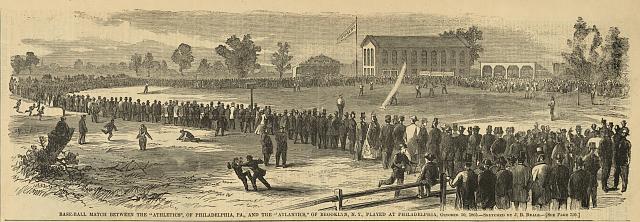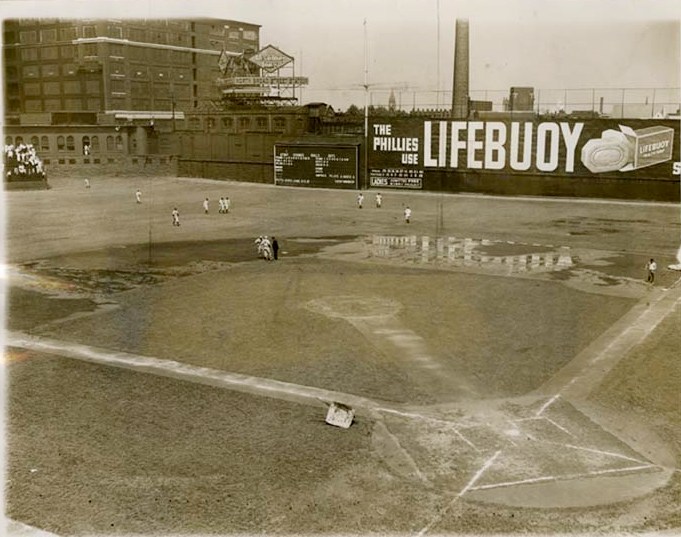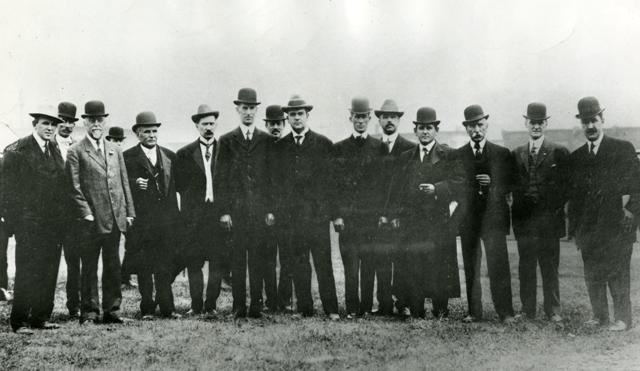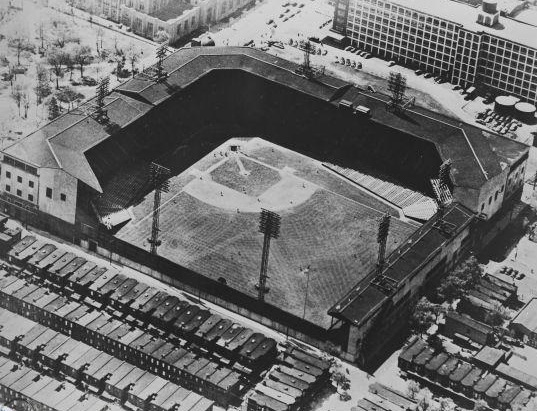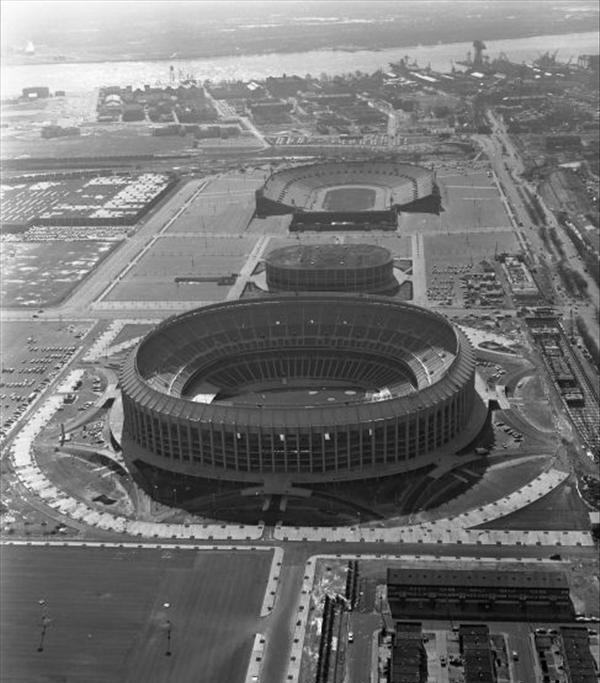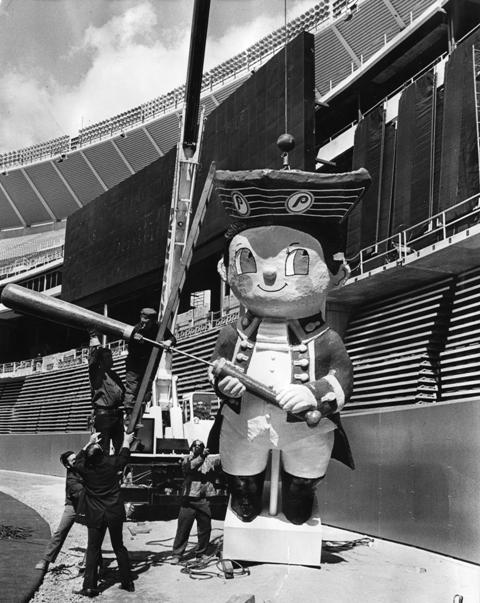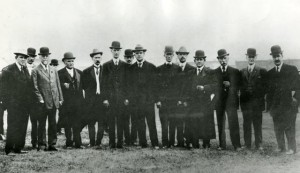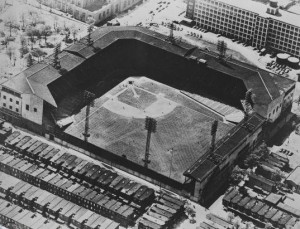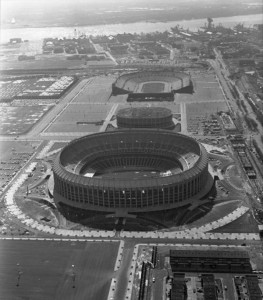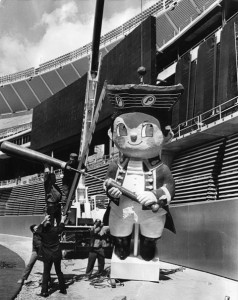Baseball (Professional)
By Ed Moorhouse
Essay
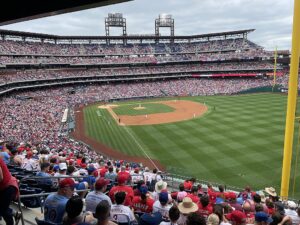
From the time the game was created to its organization into a professional league, and from the first National League game ever played to some of the earliest World Series, the city of Philadelphia has played a prominent role in professional baseball history.
Variations of the game of baseball became popular some three decades prior to the start of the Civil War. Beginning in 1833 and during the first half of the nineteenth century, a number of teams organized to play “town ball” throughout the city of Philadelphia. The popular bat-and-ball game was similar to “rounders,” an English game in which players scored by running around four bases on a square field.
As early as 1831, a Philadelphia club team known as “Olympic” played town ball while another called “Athletic” formed in 1859. Within the city limits, many games were played at Twenty-Fifth and Jefferson streets, often drawing several thousand spectators to the field. In the early to mid-nineteenth century, Philadelphia blue laws prevented clubs from playing games on Sundays, so the teams often traversed the Delaware River to play in New Jersey towns like Camden and Gloucester.
In 1845, town ball evolved into baseball with the formation of the Knickerbocker Club in New York and by 1860, the Athletics reorganized as a baseball club while other amateur teams sprang up all over the Philadelphia area. As baseball’s popularity grew throughout the country and became a form of recreation and civic pride, the sport’s first governing body was formed. The National Association of Base Ball Players grew to include more than 300 clubs — including the Athletics — by 1867. In 1866, Philadelphia hosted a championship series between the Athletics and the Atlantics of Brooklyn, which was played at Columbia Avenue and Fifteenth Street and is said to have attracted 30,000 spectators, many of whom crowded the outfield.
Paid Players

In 1865, the Athletics signed Alfred J. Reach, one of the first men paid to play the game. The emergence of paid players challenged the amateur nature of the national association which, as a result, split teams into amateur and professional groups. In 1871, the top professional teams formed the National Association of Professional Base Ball Players. Members included clubs from Boston, Chicago, New York City, and Washington, D.C., and each team traveled to and from those cities to compete. A new NAPBBP club based in Philadelphia, also called the Athletics, won the league’s inaugural championship.
Although considered to be the first professional baseball league, the National Association is not recognized as such by Major League Baseball due to various issues with instability and mismanagement during its brief existence. Instead, Major League Baseball acknowledges the National League of Professional Baseball Clubs, formed in 1876, as its founding organization. The first game in the new National League occurred in Philadelphia on April 22, 1876, between yet another team called the Athletics and the Boston Red Caps. Boston won the game by a score of 6-5 at the Jefferson Street Grounds in front of 3,000 spectators. The Athletics lasted just one season. They were expelled from the National League for refusing to make their final scheduled road trip of the season after winning only fourteen games.
Thereafter, various Philadelphia teams dissolved as quickly as they were established. Another club carrying the Athletics moniker represented the city in the upstart American Association from 1882 until the league’s collapse in 1891. This team was the first in the American Association to travel west, competing in cities like Louisville and St. Louis while playing home games at Jefferson Park. Meanwhile, the Philadelphia Quakers of the Players’ League, which lasted only one season, had games at Forepaugh Park at Broad and Dauphin Streets in 1890.
The Game Grows
Despite the failure of many professional Philadelphia baseball clubs to stay afloat at the end of the nineteenth century, the game quickly gained national appeal and its language seeped into the American lexicon. One person who held the game in high regard was Walt Whitman. The American poet played the game in his youth and incorporated some of the first reports on local games in articles for New York newspapers he edited. Later, Whitman referred to the game in his writings, admiring it for something that was wholly American and lauding its camaraderie and the athletic ability of its participants.
In 1883, the National League took a chance with establishing a new team in Philadelphia. Alfred Reach, the professional ballplayer who later made his fortune as a sporting goods magnate, was asked by league president A.G. Mills to start a new team, which Reach named the Phillies to identify it by its host city. The team played its first game on May 1 at Recreation Park on Twenty-Fourth Street and Ridge Avenue and finished its first season with a 17-81 record, which remains one of the worst marks in major league history. The dubious start was a fitting one for the Phillies, the oldest continuous one-name, one-city franchise in all of professional sports. In 2007, the Phillies suffered the 10,000th loss in team history, becoming the first professional team in any sport to achieve such a feat.
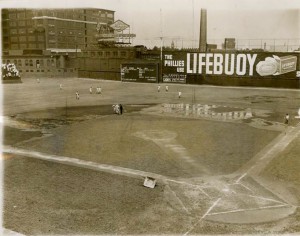
By 1895, the team had outgrown Recreation Park, which was later used by local sandlot teams, and moved into Baker Bowl, named for owner William F. Baker, on a city block at North Broad, West Huntingdon, and North Fifteenth streets at West Lehigh Avenue. The stadium was notoriously small. It could only accommodate fewer than 19,000 spectators, and the right field fence sat just 280 feet from home plate (a real advantage for hitters). The team failed to draw fans as the losing seasons piled up. The team managed to win only one league pennant during its first sixty-seven years of existence, reaching the World Series in 1915. Over the next thirty-five years, the Phillies endured one of the worst stretches in team history, finishing in last place sixteen times. While the Phillies redefined futility in the early twentieth century, their American League counterpart flourished.
The Athletics Ascend
Founded in 1901 as a cornerstone franchise of the new American League, the latest Philadelphia Athletics team became a model club, winning eight pennants and five world championships during its fifty-four-year stay in Philadelphia. A former National League player and manager, Connie Mack, was charged with finding financial support, players, and a field for the team. Benjamin Shibe, who had been Al Reach’s partner in the sporting goods business, invested in Mack’s Athletics. In 1909, the A’s moved from Columbia Park to Shibe Park at Twenty-First Street and Lehigh Avenue (some nine blocks from the Phillies’ Baker Bowl), with row houses to the south of Lehigh and commercial and industrial enterprises to the east. Many Athletics players lived within a few blocks of the park, and rookies took up residence on Twentieth Street. The area was predominantly Irish, a boost to team loyalty, especially because of Mack, born Cornelius McGillicuddy to Irish immigrants in Massachusetts in 1862. In 1910, the Athletics won the city’s first World Series championship and claimed two more in 1911 and 1913. Given the team’s success, fans came to Shibe Park in droves, walking up Lehigh Avenue from their homes, crowding streetcars to get to the stadium, and gathering on rooftops that stood tall over right field just to catch a glimpse of Mack’s A’s. The area around the ballpark prospered with businesses and residences while support for the team reached a fever pitch.
While the Athletics brought winning baseball to Philadelphia, baseball became more popular than ever as leagues even sprang up in shipyards during World War I. In 1918, the Delaware River Shipbuilding League included baseball clubs from shipyards in Bristol, Chester, Cornwells, and Philadelphia in Pennsylvania; Camden, N.J.; and Wilmington, Del. Games played in those shipyards were well-attended by fans throughout the summer months. The teams were made up of shipyard workers, including recent or retired big league ballplayers. Charles “Chief” Bender, of the 1909 A’s, pitched for the Hog Island shipyard team and was one of the better-known pros to play in the league. Famously, “Shoeless” Joe Jackson played for the Harlan & Hollingsworth team of Wilmington, which beat Standard Shipbuilding of Staten Island, N.Y., in an Atlantic coast shipyard championship played in Baker Bowl and at New York’s Polo Grounds. The league folded in 1919.
In the professional ranks, the Athletics lost the 1914 World Series to the Boston Braves, causing Mack to sell off his top players. The A’s finished in last place for seven straight seasons, but began to climb from the bottom rungs of the American League in the latter half of the 1920s, when Mack rebuilt the team around players like Jimmie Foxx. The Athletics won back-to-back World Series in 1929 and 1930 and made a World Series appearance in 1931. Over the next twenty years, however, the A’s finished no better than fourth in the standings and were in last place eleven times while attendance waned. While the Athletics scuffled, things weren’t much better for the Phillies, who moved in to share Shibe Park with the A’s in 1938. It had gotten so bad for the Quaker City’s National League franchise that pitcher Hugh Mulcahy earned the nickname “Losing Pitcher” because he ended up on the losing end of so many of the Phillies’ games. The team even tried to change its name in 1942 to the Blue Jays because “Phillies” had become associated with so much losing.
At the same time, World War II impacted major league teams like the Phillies, which watched its players get drafted into military service. In 1941, Mulcahy became the first major league player drafted into war. Due to travel restrictions, teams were not permitted to hold their typical spring training in Florida, so the Phillies prepared for upcoming seasons in Hershey, Pa., while the Athletics practiced in Wilmington. After the war, the Phillies finally began to have some success. In 1950, the team returned to the World Series after a thirty-five-year absence. Led by future Hall of Famers Robin Roberts and Richie Ashburn, the “Whiz Kids” (as they were nicknamed because of their youth) won ninety-one games and clinched the National League pennant over the Brooklyn Dodgers on the final day of the season before losing the World Series to the New York Yankees in four games.
Minor League Teams All Over
With two professional teams in Philadelphia, the city began expanding its baseball footprint throughout the U.S. and Canada with minor league affiliations. The A’s were the parent club to minor league teams in Williamsport, Pa.; Elmira, N.Y.; Lincoln, Neb.; Savannah, Ga.; and even Toronto and Ottawa in Canada. The Phillies had players develop in minor league outposts throughout New York, Florida, Arkansas, California, Oregon, Oklahoma, and Pennsylvania, among other states. In 1967, the Phillies began a partnership with Reading, Pa., which remains the home of the Double A Reading Fightin’ Phils. The team currently has farm clubs in Allentown, Pa.; Williamsport, Pa.; Clearwater, Fla.; and Lakewood, N.J., and hosts rookie league teams in the Dominican Republic and Venezuela. Minor League Baseball’s presence in the region also includes a team in Wilmington, Del. (affiliated with the Kansas City Royals) and the independent Camden Riversharks of the Atlantic League, while various semi-pro leagues compete throughout the region.
The first all-black baseball teams began playing in Philadelphia in the 1860s, and Negro League teams played into the early 1960s, despite the integration of Major League baseball in the late 1940s. Philadelphia teams were among the last to integrate. In 1953, a year before their final season in Philadelphia, the A’s signed the first black player in team history in pitcher Bob Trice. Philadelphian Roy Campanella followed Jackie Robinson to the Brooklyn Dodgers a year after he joined the team in 1947. During his first year in Major League Baseball, Robinson was met with racist abuse from other teams, including the Phillies, who did not sign a black player until 1952. It was not until 1957 that a black player, shortstop John Kennedy, would make the Phillies out of spring training.
On September 19, 1954, the once-proud Athletics lost their final game in Philadelphia to the New York Yankees, 4-2. The franchise was sold to businessman Arnold Johnson, who moved the team to Kansas City in 1955. The A’s moved to Oakland in 1968. At the start of the 1960s, after the A’s had been relocated, the Phillies were still floundering. But in 1964, the team was seemingly on its way to recapturing some of the magic the Whiz Kids had enjoyed more than a decade earlier. Under the ownership of Bob Carpenter and the leadership of manager Gene Mauch, the 1964 Phillies raced out to a fast start. Everything was in place for the team’s third World Series appearance, but with twelve games to play in the regular season, the Phillies blew a six-and-one-half-game lead to finish in second place. The collapse haunted the Phillies and thereafter became a byword for baseball futility.
The Veterans Stadium Era
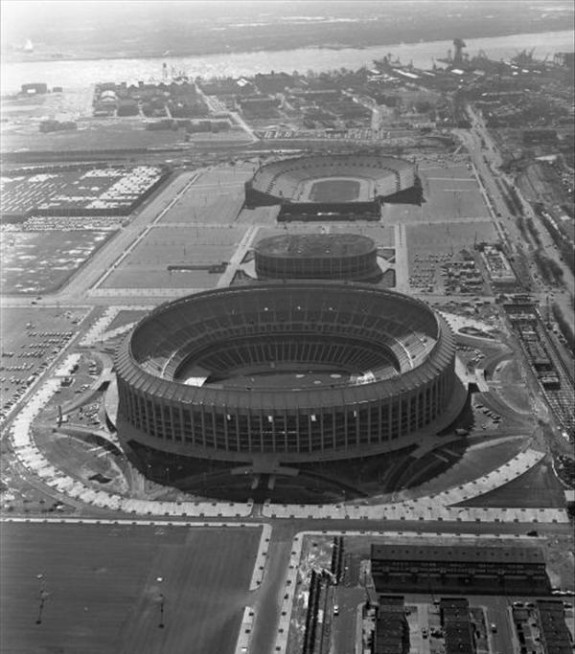
Less than a decade later, the Phillies moved into Veterans Stadium, a 60,000-seat multi-sport venue located off of Interstate 95 in South Philadelphia that they shared with the Eagles of the National Football League. Named in tribute to the veterans of all wars, “the Vet” became known more for its artificial playing surface and the rowdy, vociferous fans who watched games from its upper levels than the teams that played there. Despite the notoriety of the home park, the Phillies enjoyed a stretch of success during which they appeared in three straight National League Championship Series, from 1976 to 1978. In 1980, ninety-seven years after Alfred Reach brought the Phillies to Philadelphia, the franchise finally won a World Series. Following their first championship, the Phillies had sporadic success, returning to the World Series again in 1983 and 1993, but they often remained league basement dwellers. In 2004, the team moved into Citizens Bank Park, a 43,000-seat natural grass stadium situated across from Veterans Stadium, which was later torn down. It was here where the Phillies enjoyed their most successful run, winning five consecutive National League Eastern Division titles from 2007 until 2011 while selling out a National League record 257 consecutive games. The team appeared in back-to-back World Series for the first time ever, defeating the Tampa Bay Rays in 2008.
With roots in America’s birthplace, baseball — America’s great pastime — is more than just a game. In Philadelphia, it became as synonymous with the city as the U.S. Constitution, a symbol of civic pride and passion, connecting the generations of the city’s people who first played early versions of the game on the Jefferson Street Grounds to fans who streamed to ballparks throughout the region every summer.
Ed Moorhouse is an editorial/media specialist at Rutgers–Camden. (Author information current at time of publication.)
Copyright 2014, Rutgers University.
Gallery
Backgrounders
Connecting Headlines with History
- New Jersey team helps re-create baseball's beginnings as game of gentlemen (WHYY, July 24 2015)
- Celebrating 150 years of baseball in Delaware (WHYY, October 2, 2015)
- Vintage Base Ball season opener in Hammonton on Saturday (WHYY, April 4, 2017)
- Joe Girardi fired by Phillies, replaced by Rob Thomson (Associated Press via WHYY, June 3, 2022)
Links
- Baker Bowl (ExplorePAHistory.com)
- Camac Woods: Camac Woods and Early Philadelphia Baseball
- Departure Without Dignity: The Athletics Leave Philadelphia (Society for American Baseball Research)
- Philadelphia Phillies: the Movingest (Not the Losingest) Team in Baseball (PhillyHistory.org
- Shibe Park/Connie Mack Stadium (ExplorePAHistory.com)
- There Used to Be a Ballpark Here (PhillyHistory.org)
- Veterans Stadium (ExplorePAHistory)
- Up Close on Baseball's Borders (The New York Times)
